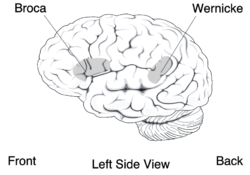Understanding the language is the ability of the human being to process and understand spoken and written language, this ability has helped us a lot throughout our evolutionary history, the ability to communicate effectively has allowed us to collaborate and create complex societies to face a hostile world For this reason, in the brain, we find biologically rooted structures , such as the Wernicke region.
A key aspect of the neural arrangement of the tongue is that it is lateralized. In other words, the vast majority of language-related structures are found in the left hemisphere; It is true that there are studies that claim that processes such as jokes, pragmatism and sarcasm are handled in the right hemisphere, so the Wernicke area, responsible for language understanding, is located in the left hemisphere, mainly in zones 21 and 22, depending on the Brodmann area.
- In this article we will discuss two fundamental aspects to understand the involvement of the Wernicke area in language.
- The first being its anatomical and functional aspects.
- And the second.
- Wernicke’s aphasia.
- Caused by injuries in this area.
In addition to Zones Brodmann 21 and 22, which are the nerve center of the Wernicke area, there are other structures involved in language understanding. When we talk about the Wernicke Extensive Area, we also include zones 20, 37, 38, 39 and 40. They participate in the association of words with other information.
The Wernicke region is closely related to the primary auditory cortex, which is consistent with its role in understanding spoken language. At the anatomical level, it is also remarkable to talk about the great connections that this system has with the Broca region; this area is primarily responsible for language understanding. These two zones (Wernicke and Broca) are connected by a series of neural rays that, in turn, form what is called the arc-shaped booklet.
The functions of the Wernicke area are
These functions are the pillars that underpin understanding the appropriate language that enables communication. As a result, injuries in the Wernicke area can have significant negative consequences when using language and managing communication. In the next section, we will discuss the specific consequences of injuries in this area.
Wernicke’s aphasia is a speech production disorder caused by an injury in the Wernicke area. This disorder is characterized by unstructured and meaningless speech, with a disturbing understanding of language. But, although the message makes no sense, the discourse is transmitted fluently and effortlessly, since the production of language is intact.
Unlike Broca’s aphasia, the patient uses a lot of functional words, using complex verbal times and subordinate sentences; on the other hand, it uses few words with content and these words do not come together to form meaning, this is mainly due to an effect called semantic parallelxia, a phenomenon by which, instead of saying the desired word, they pronounce a different word with a similar meaning; this is because the Wernicke region is not accurate in selecting words by meaning.
A key aspect of Wernicke’s aphasia is that the language domain is completely intact. People with this disorder don’t have trouble keeping a speech effortlessly, even if it doesn’t make sense. This is because the brain structure responsible for speech production is the Broca. This helps us understand that the Wernicke area specializes in understanding language and semantics and, despite their connections to other domains, can independently monitor their operation.
Finally, there is a curious process when an injury appears in linguistic areas at a very young age, due to the high plasticity of the brain, if the left hemisphere is damaged, it is possible that the tongue develops in the right hemisphere. As a result, brain damage that occurs before language consolidation can be reduced, allowing for normal or virtually normal development.

